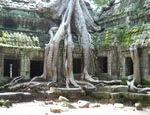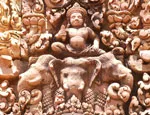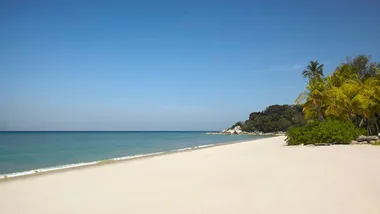Swallowed up by the jungles of northern Cambodia, the temples of Angkor were lost for hundreds of years after the fall of the great Khmer empire that held sway over most of Indochina from the ninth to the 14th centuries. Occasionally, wandering Buddhist monks would stumble on some of the huge stone complexes, stopping to rest and pray, but for the rest of the world, this architectural wonder was merely a legend.
When French botanist Henri Mouhot stumbled on Angkor in 1861, its re-discovery caused a sensation in Europe. With the publication of Mouhot’s illustrated bookVoyage a Siam et dans le Cambodge, an intriguing fable became fact — a spectacular city, for so long only believed to exist in the imagination, rose out of the misty jungles of the Orient.
Almost 150 years later, Angkor has become one of the most visited architectural sites in the world, and today more than 100 temples cover an area of 320 square kilometres, standing testament to a civilisation that once held sway from the tip of southern Vietnam to Yunnan in China and from Vietnam west to the Bay of Bengal.
It’s easy to spend a week or more based at Siem Reap on the doorstep of Angkor, seeing the temples at a leisurely pace, returning to the main attractions through the day to catch them in different light conditions. Most people spend between two to five days. Two days gives you enough time to visit the main sites once — as long as you rise early and spend most of the day in the field — but five days ensures a more leisurely visit with breaks in the afternoon when temperatures and humidity levels rise.
The temples
Angkor Wat
The largest and most breathtaking of all the monuments, this funerary temple for a great king was built to honour the Indian Hindu deity Vishnu. Surrounded by a 190-metre-wide moat, this three-storey building is adorned with galleries, cupolas and a 55-metre-high central tower shaped like a lotus bud. The structure measures 1.5km long and 1.3km wide and is famous for its exquisite bas-reliefs — a gallery of 800 metres with carved stone panels depicting people, scenes of 12th century life, wars and the gods.
Go before daybreak to take beautiful photographs of the sunrise with gorgeous reflections in the lily ponds in front of the main edifice. Later in the morning, this temple gets very crowded, so it’s worth returning for quieter moments in the early evening.

Temples in Cambodia
Angkor Thom
This is a city within a city (10sq km) surrounded by a stone wall and several impressive stone gateways with gargantuan faces. Inside the city are some important monuments, including the Bayon, the Baphuon, the Royal Enclosure and the Terrace of Elephants.

Temples in Cambodia
+ The Bayon is the second most visited complex at Angkor. It consists of 54 towers decorated with more than 200 smiling giant faces and corridors that contain 1200 metres of bas-relief incorporating 11,000 figures. Climb the steep stairs to the uppermost platform where you’ll be surrounded by the giant enigmatic stone faces.
+ Baphuon is built like an intricately decorated pyramid and is said to be a representation of mythical Mt Meru from the Hindu creation story.
+ The Royal Enclosure is a 350-metre-long terrace that once served as the king’s area for grand audiences. Nearby is the Terrace of Elephants, so called because of the stone elephants that line it.
Phnom Bakheng
About 400 metres south of Angkor Thom, this temple on a hill overlooking Angkor Wat is where many visitors come to take a sunset photo of the great monument. It’ll be crowded with other visitors and pesky boys selling cold drinks. To take a good photo, you’ll need a 300mm telephoto lens and a tripod. The temple of Phnom Bakheng is a five-tiered man-made mountain with seven levels and 44 towers at the base.
Banteay Kdei
A massive 12th century Buddhist temple surrounded by four concentric walls and four stone entrances decorated with garudas (mythical birds).
Ta Prohm
This temple is as popular as Angkor Wat and the Bayon mainly because it’s still covered in jungle and looks like the monuments did when European explorers first visited. Cloaked in dappled shadows from the rainforest canopy, the temple appears to be held up by the giant roots and trunks of massive fig trees. It’s an atmospheric temple with towers, close courtyards and narrow corridors forever tinged in green.

Preah Khan
Preah Khan
This is a good counterpoint to the similar structure of Ta Prohm. Preah Khan is one of Angkor’s largest structures, has been cleared of jungle and has been mostly restored. It may be less popular than Ta Prohm, but it’s in a better state of preservation, especially the long vaulted internal galleries. Four processional walkways approach the gates of the temple and these are bordered by gods carrying serpents. A quiet backwater, this less-frequented site is often silent but for the chatter of tiny squirrels.
Preah Neak Pean
A temple of pools, the largest one surrounding a circular “island” encircled by two massive nagas (serpent dragons), whose intertwined tails give the temple its name.
Preah Ko
This is a smaller temple from the late ninth century. Its six brick towers contain carved sandstone and plaster reliefs and there are three sacred oxen statues at the front of the temple.
Bakong
The largest and most interesting of the Rolous group of temples is this five-tiered pyramid built from sandstone, 60 metres at the base, with eight towers, 12 stupas and a Buddhist monastery in the south-east corner.
Banteay Srei
Off the beaten track, this pink sandstone jewel of a temple, Banteay Srei, is a 10th-century Hindu sanctuary known as the Citadel of Women because of its exquisite filigree carvings of women and female divinities. Surrounded by pools, it has two entrances and three towers also covered in fine carvings. A must for those taking the trouble to see some of the outer temples.

Stone carving in Cambodia
Travel essentials
Creative Holidays (www.creativeholidays.com.au) has a four-night/five-day Cambodia In Depth tour, which visits the Cambodian capital of Phnom Penh, and then Udong and the infamous Killing Fields, Siem Reap, Angkor Wat and the other temples of Angkor (from $774 per person, airfares not included). Its Fly & Tour Cambodia in Depth package includes the above and economy class airfare from Australia to Phnom Penh, returning from Siem Reap to Australia on Vietnam Airlines (from $2047 per person, twin-share; April 1 to August 31, 2007). For bookings, contact your travel agent.



